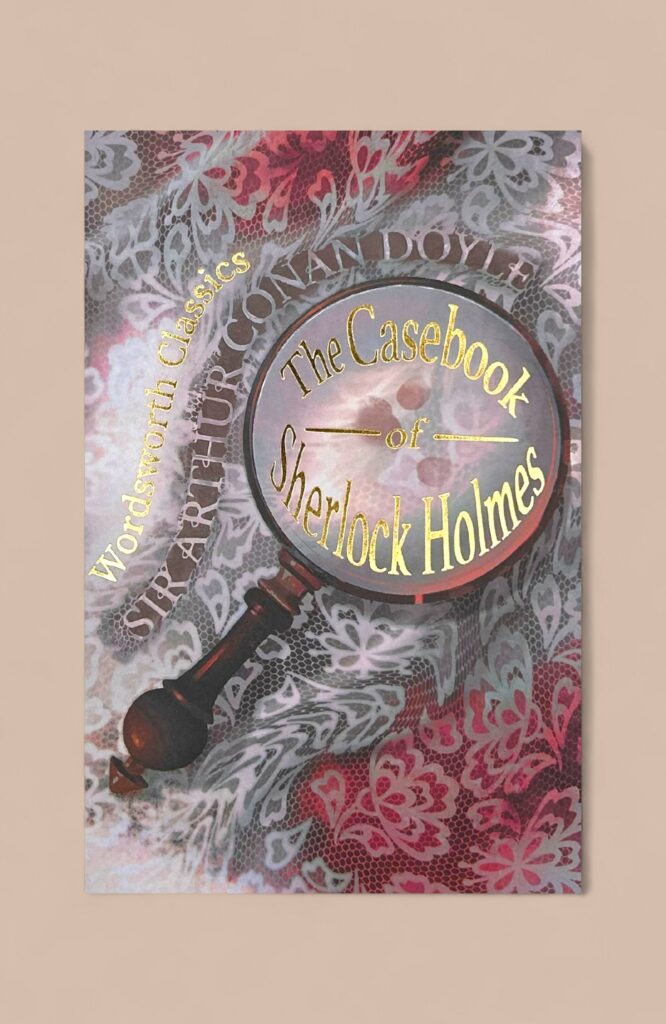
Sherlock Holmes in 1924: A Centenary
Sherlock Holmes fiction probably conjures up images of fog bound London streets, hansom cabs and cosy scenes in 221b Baker Street with its Victorian décor. However, this year marks the centenary of the publication of three particular Sherlock Holmes short stories and it may seem strange to think of Sherlock Holmes in the 1920s. ‘The Adventure of the Sussex Vampire’ was first published in The Strand Magazine in January 1924. This was followed by ‘The Adventure of the Three Garridebs’ in the American magazine Colliers in October 1924, later appearing in The Strand Magazine in January 1925. Colliers also featured ‘The Adventure of the Illustrious Client’ in November 1924 and once again The Strand Magazine followed in suit in February – March 1925.
It seems to be taken as a given by Holmes aficionados that the quality of Conan Doyle’s earlier Holmes stories far outweigh those produced later in his life. The final collection of stories The Casebook of Sherlock Holmes, which includes the three aforementioned stories, does indeed contain some of the weaker tales in terms of plotting and solution. This collection is discussed by David Stuart Davies in his blog of 5 June 2020, and as he suggests, many of the stories have a somewhat darker edge.
I thought it might be interesting to cast a tighter focus on these three stories as this year marks their centenary. How then, does Conan Doyle locate Holmes within the decade of the 1920s? Well, the answer is, that he largely avoids doing so. One of the ways around this is to have the stories told in retrospect, indeed two of the three stories are set in 1902 which allows Conan Doyle to keep that familiar feel. Let’s move to consider each of the stories in turn.
‘The Adventure of the Sussex Vampire’
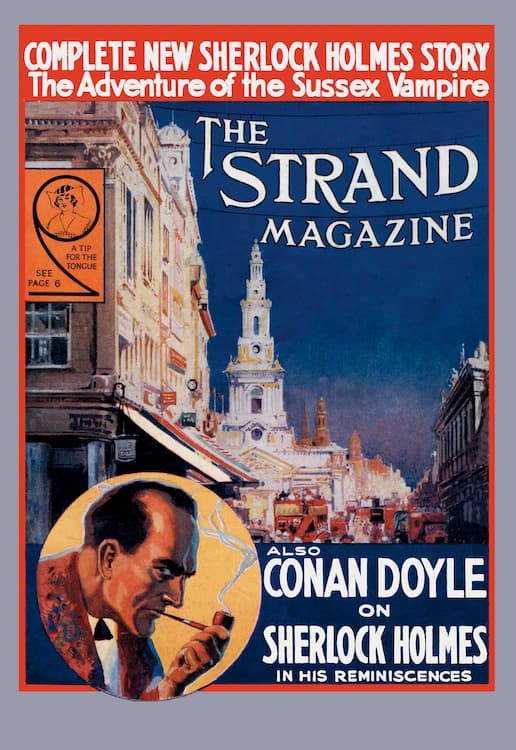
Strand Magazine January 1924
David Stuart Davies notes that Conan Doyle wrote little fiction during the final decade of his life, preferring instead to devote his energies to his ever-growing interest in Spiritualism. Indeed, the stories collected in The Casebook were largely written to finance his exploits. It may come as a bit of a surprise then, to find Holmes adopting the stance of a sceptic when it comes to anything supernatural. On receipt of a letter requesting his expertise in a matter concerning vampires, Holmes responds with a ‘dry chuckle’ and declares to Watson ‘This Agency stands flat-footed upon the ground, and there it must remain. This world is big enough for us. No ghosts need apply.’
Before beginning to investigate the case Holmes describes the notion of vampires as ‘pure lunacy.’ Vampires in fiction were well established by this time, although may have slipped from the public imagination, as this story was published some twenty-seven years after that most well-known work of vampire fiction – Dracula. Holmes is consulted by a Mr Robert Ferguson on behalf of a friend who has married a lady from Peru, following the death of his first wife. For five years the marriage had been happy until the Peruvian wife began to exhibit some worrying traits. She was caught assaulting his fifteen year old son from the previous marriage. Later, matters came to a head when the nurse caught her in some worrying behaviour with their new born baby. The nurse had seen her apparently sucking blood from the neck of the baby. The husband refused to believe his sweet wife capable of such an act, so imagine his horror when he later saw his dear wife do so with his own eyes. As Ferguson says, vampirism was ‘some wild tale of foreign parts. And yet here in the heart of English Sussex.’ Thus, instead of the likes of the Eastern European vampire threatening Yorkshire and later London à la Dracula, we have a South American mother threatening the heart of the home counties domestic realm.
There is little about this story which moves it beyond the Victorian age. If anything, quite the reverse. As frequently happens when Holmes and Watson leave London, they do not find a rural idyll on their arrival. If in doubt, think of the perilous Dartmoor in The Hound of the Baskervilles. This mystery takes them to the somewhat tamer location of Sussex, but it is a Sussex much located in the past. As they travel along ‘a long winding lane’ on a ‘dull, foggy November day’ they encounter Ferguson’s ‘ancient farmhouse’ with its ‘tall Tudor chimneys’. There is little evidence of modernity inside the dwelling as Watson observes ‘a singular mixture of dates and places.’ He identifies a fireplace as from 1670 and imagines the room could have ‘belonged to the original yeoman farmer of the Seventeenth Century.’ This sense of past is indeed a fitting setting for a vampire mystery. However, Holmes claims to have solved the mystery before even leaving Baker Street and merely needed to visit the house in order to carry out some further observations before confirming his theories. If you happen to remember the very loosely based 1993 TV adaptation entitled The Last Vampyre, starring Jeremy Brett, you may find yourself a little disappointed at the brevity of the solution to this story. Nevertheless, it is worth a read, not least to see the deductive powers of Sherlock Holmes in action.
‘The Adventure of the Three Garridebs’
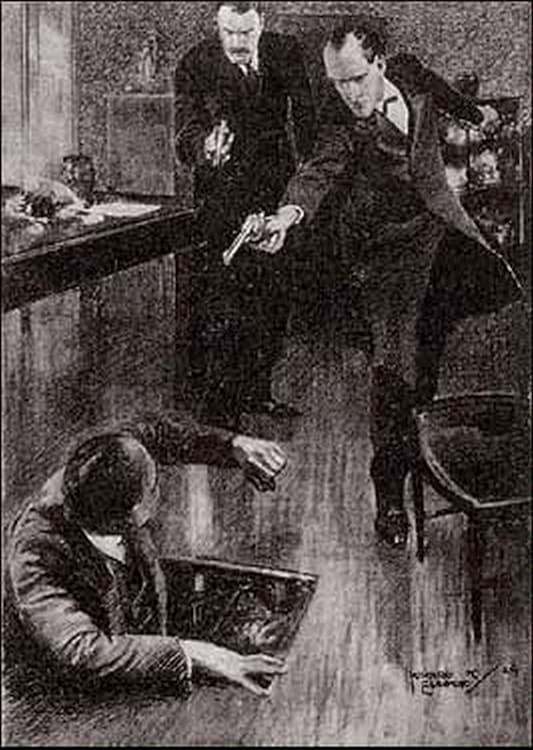
Strand Magazine – The Advenure of the Three Garridebs
Unlike the previous story which has no specific date with which to identify its timeframe, in ‘The Adventure of the Three Garridebs’ Watson is more specific and refers to ‘the latter end of June, 1902, shortly after the conclusion of the South African war.’ Watson tells the reader it was also ‘the same month that Holmes refused a knighthood for services which may perhaps some day be described.’ Thus, the setting is immediately connected with the personal and heroic (the earning and refusal of the knighthood) and the wider political landscape (the South African war).
There is some sense of modernity in that the Baker Street residence now has a telephone which Holmes makes use of, or rather instructs Watson to place a call before taking over the making of arrangements. The originally published story featured an illustration by Howard Elcock depicting Holmes grasping the telephone, looking firmly thoughtful.
This is quite an intriguing story from the title (indeed, what are Garridebs), to the opening paragraph, through to the conclusion of the story. Watson as narrator begins:
It may have been a comedy, or it may have been a tragedy. It cost one man his reason, it cost me a blood-letting, and it cost yet another man the penalties of the law.
Thus, from the introduction we know a crime was committed which was duly punished. We also know there will be a degree of peril and that Watson will be injured, although not severely enough to prevent him from recording the case.
To answer my earlier question, Garrideb refers to a family name, and this is where the mystery begins. Holmes receives a visit from a Mr John Garrideb from Kansas, although in his usual and regular early display of brilliance in the narrative, Holmes deduces John Garrideb has been in England for some time because as Holmes declares ‘Your whole outfit is English.’ John Garrideb appears to be a reluctant client, as it was a Mr Nathan Garrideb who initially wrote seeking the expertise of Holmes, much to the annoyance of the aforementioned John. Furthermore, he reluctantly and somewhat grudgingly agrees to the presence of Dr Watson as he surveys him “with not too friendly a gaze.” The problem appears to concern an inheritance dictated by the Will of a wealthy American landowner by the name of Alexander Hamilton Garrideb. John describes this as ‘the queerest Will that has ever been filed in the state of Kansas.’ He goes on to explain the terms as follows:
His property was divided into three parts, and I was to have one on condition that I found two Garridebs who would share the remainder. It’s five million dollars for each if it is a cent, but we can’t lay a finger on it until we all three stand in a row.
Furthermore, these three Garridebs must be adult males. So far, so simple? Well no, not quite. Whilst agreeing to investigate, Holmes privately declares to Watson the words of John Garrideb to be a ‘rigmarole of lies’ and that he is a ‘complex and ingenious’ rascal. Thus the real mystery begins. After the investigation has progressed a while Holmes warns Watson there is danger ahead and insists he takes his revolver. Whilst I do not wish to reveal the outcome of the mystery, we already know Watson sustains an injury. Although, as previously indicated, this story does not have the feel of the 1920s, there is evidence of the passage of time through a moment of development in the Holmes/Watson friendship. This follows the moment when Watson is injured and our narrator allows himself a little emotion in his recording of the reaction of Holmes:
It was worth many wounds – to know the depth of loyalty and love which lay behind that cold mask. The clear, hard eyes were dimmed for a moment, and the firm lips were shaking. For the one and only time I caught a glimpse of a great heart as well as of a great brain.
No doubt Sherlock Holmes would strongly disapprove of such a display of sentimentality in Watson’s record of this case.
‘The Adventure of the Illustrious Client’
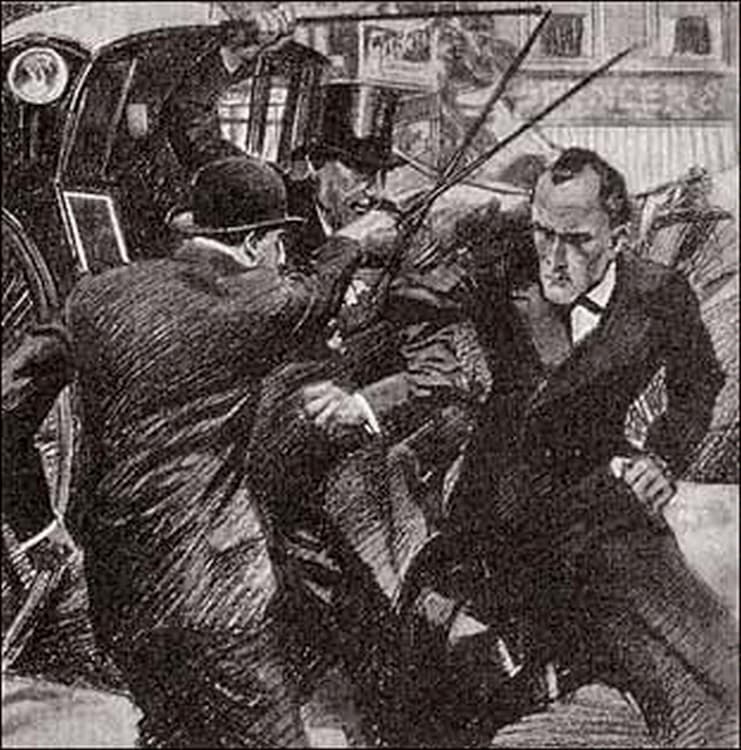
Strand Magazine – The Adventure of the Illustrious Client
This is another retrospective tale as Watson alerts the reader the adventure began on ‘September 3rd, 1902.’ The relaying of the tale starts, as in the majority of the stories, with the arrival of a potential client into the sanctity of the Baker Street apartment. This time, the visitor is Colonel Sir James Damery, however, he is merely acting as an intermediary and refuses to reveal the identity of the actual client. This almost brings the adventure to an end before it has a chance to begin as Holmes declares:
I am accustomed to have mystery at one end of my cases, but to have it at both ends is too confusing. I fear, Sir James, that I must decline to act.
Despite these words, Holmes relents and allows Sir James to put forward his case which concerns the ‘young, rich, beautiful, accomplished’ Violet de Merville who has fallen in love with Baron Gruner. Holmes recognises the name and identifies him as ‘the Austrian murderer’ and makes comparison with his nemesis, Professor Moriarty. On this basis, Holmes relents and agrees to look into the problem.
The evil and manipulative Baron Gruner appears to be a worthy opponent from the outset. His reputation precedes him as Holmes is already aware of some of his crimes, including murder. In an early encounter between the two super-minds the Baron calmly informs Holmes he will ruin his reputation if he persists with the investigation as he will undoubtedly meet with failure. If this is not deterrent enough the Baron issues a clear threat of physical violence. All this is achieved with a smile and a chuckle.
There is much to say about this story which, in addition to its 1902 setting, has the familiar feel of the late Victorian classic Holmes story despite its publication date of 1924. One such example is Watson’s recourse to the popular Victorian pseudo-science of physiognomy, whereby it was theorised that a person’s character could be judged by facial characteristics. On first meeting Sir James, Watson directs the reader that his ‘bluff, honest personality’ was evident from his ‘broad, clean-shaven face, above all, that pleasant, mellow voice. Frankness shone from his grey Irish eyes, and good humour played around his mobile smiling lips.’ Contrast this with Dr Watson’s first encounter with Baron Gruner whereupon he notes ‘his straight, thin-lipped mouth. If ever I saw a murderer’s mouth it was there – a cruel, hard gash in the face, compressed, inexorable, and terrible.’
As previously mentioned, many of the stories in this collection have a darker feel. ‘The Adventure of the Illustrious Client’ is a definite example of this. Whilst not wishing to give away the ending, it is one of the more sinister, and violent of the stories. It features psychological manipulation, a violent ambush and an acid attack. It is such content as this which maybe marks out the movement of Sherlock Holmes into the 1920s.
Denise Hanrahan Wells
Main image: Statue of Sherlock Holmes by John Doubleday 1988, Meiringen, Switzerland. Credit: Kim Gordon-Bates / Alamy Stock Photo
Image 1 above: The Strand Magazine January 2024 Credit; Alamy Stock Photo
Image 2 above: The Strand Magazine illustration for ‘The Adventure of the Three Garridebs’. Credit: Tibbut Archive / Alamy Stock Photo
Image 3 above: The Strand Magazine illustration for ‘The Adventure of the Illustrious Client’. Credit: Tibbut Archive / Alamy Stock Photo
Strand magazine artwork by Howard K. Elcock
Our paperback edition of The Casebook is here and the hardback here
Both include the story collection His Last Bow.
The website of The Sherlock Holmes Society can be found here.
Sherlock Holmes in 1924: A Centenary
Sherlock Holmes in 1924: A Centenary
Sherlock Holmes in 1924: A Centenary
Sherlock Holmes in 1924: A Centenary
Sherlock Holmes in 1924: A Centenary
Sherlock Holmes in 1924: A Centenary
Books associated with this article
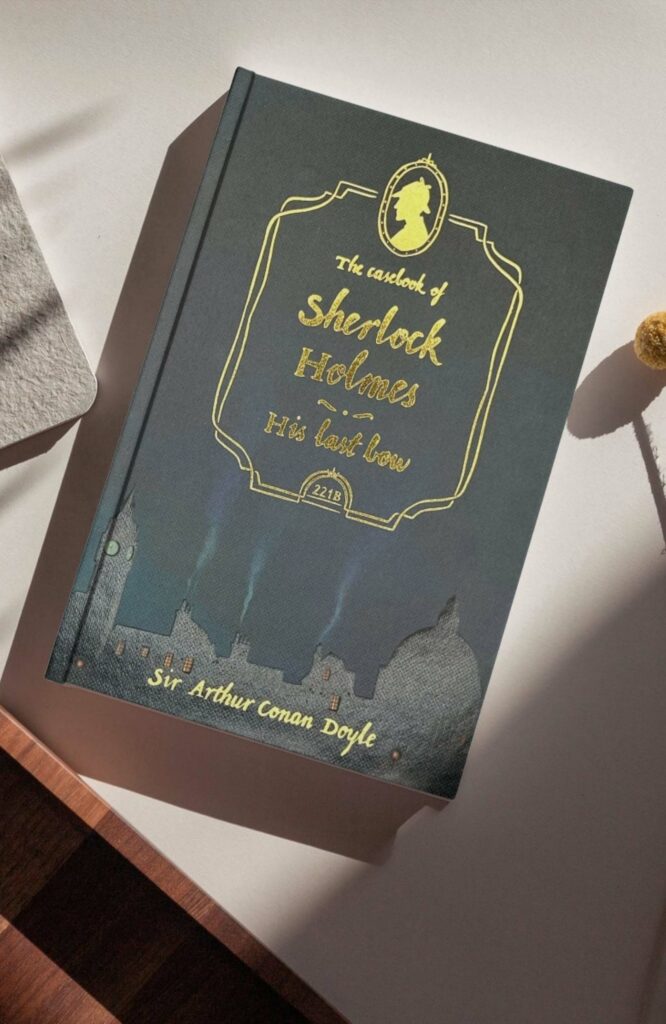
The Casebook of Sherlock Holmes & His Last Bow (Collector’s Edition)
Sir Arthur Conan Doyle
